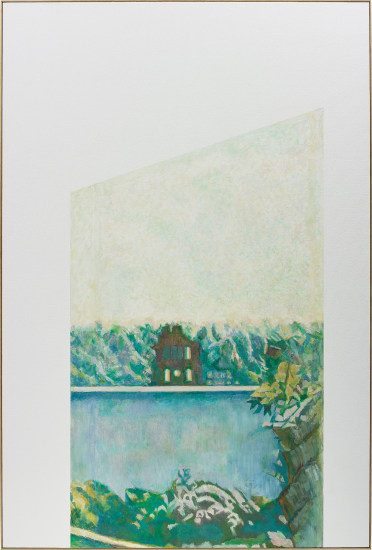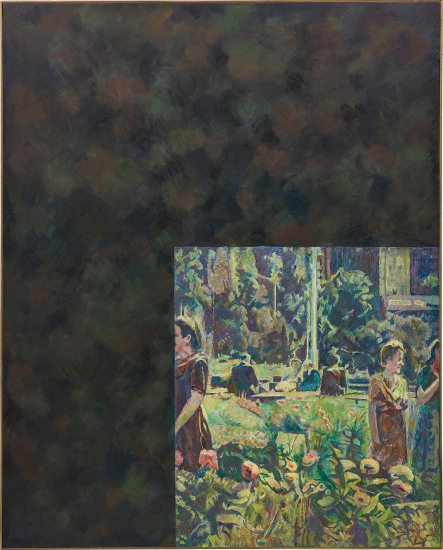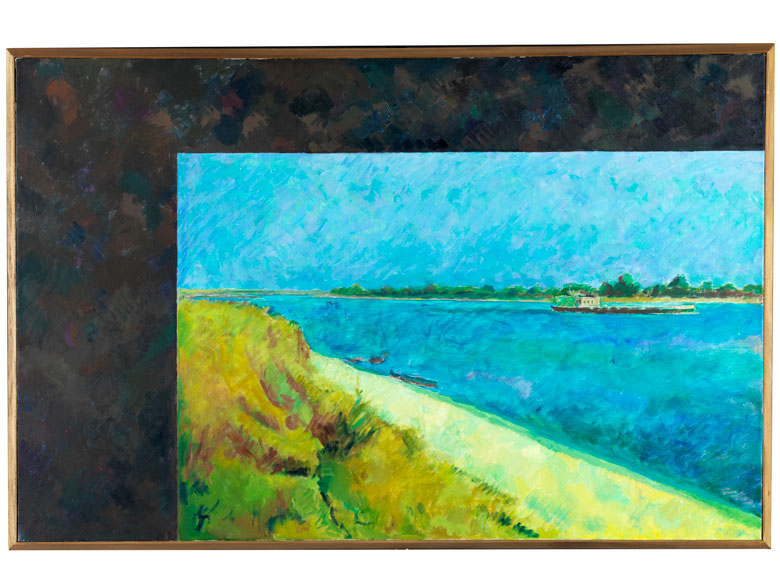PROPERTY FROM THE VALENCIA CONTEMPORARY ART COLLECTION Ilya Kabakov and Emilia Kabakov The Painting on an Easel 1998 Oil on canvas and wooden easel. Site specific installation with variable dimensions. Easel: 207 x 65 x 60 cm. (81 1/2 x 25 1/2 x 23 1/2 in); Painting: 143 x 228 cm (56 1/4 x 89 3/4 in).
Provenance Collection of the artists; Sean Kelly Gallery, New York Exhibited Antwerp, Museum van Hedendaagse Kunst, 16 Installaties, 17 April–23 August 1998; Goslar, Monchehaus Museum fur Moderne Kunst, Ilya Kabakov 16 October, 1998–3 January 1999 Literature 16 Installaties, exh. cat., Museum van Hedendaagse Kunst, Antwerp, 1998 (illustrated); Ilya Kabakov Catalogue Raisonné Installations 1983–2000, vol. 2, Düsseldorf, 2003, pp. 280–83 (illustrated) Catalogue Essay "My father was a great prankster – he figured out a way to drag an old piano in a cage through the streets of the city! I also love to joke. The question is: why must all things stand up on the floor – they could easily wind up on the ceiling. A table, chair, bed – everything could ‘stand' there just beautifully, if you attach them right. True, there is a danger: one of these objects could fall on your head, for example, the lid of a teapot, a cushion from the couch. ... A complete, radical shift of things is not necessary, something should be left in its old place, and a happy medium should be sought, everything should be harmonious. That's how all wise politicians act, just like my grandmother: whenever she put fresh food on the table, she would always add something left-over from yesterday's dinner." Text in the installation The Painting on an Easel is a powerful manifestation of the Kabakovs' ability to question the history of artistic practice and challenge traditional practice. To the Kabakovs, the installation of The Painting on an Easel is the most important aspect, so that, while the painting, an idyllic Russian village on a summer's day, appears to float at eye level, all is not what it seems (typically of the Kabakovs' work), and the viewer's eye is pushed beyond the realm of the canvas to the easel that is suspended from the ceiling. The subject matter and the painting itself thus appear to lose substance or meaning as an object of contemplation and instead takes on an air of the unlikely or the absurd, ie. the impossible existence of an ‘ideal' Soviet landscape. "J. Bakshtein: ...it is clear that this is like a model for Soviet existence that was elaborated throughout the lives of Soviet people: no matter how the everyday circumstances of life changed around a person, he, in order to live, had to become a tightrope-walker like Chaplin. He constantly had to twist and turn, deceiving himself and others in his outer life, the life of Soviet socium, so that his own apartment and family could remain in relative stability. Ilya Kabakov That's rather accurate, but there is yet another meaning, another image: in today's art situation, where everything is so tightly wound, in order to exhibit something natural and simple that you really love and know, you have to twist it and turn it around so much so that, recognizing you as a modernist, avant-garde etc., people will actually look carefully at what you really want to say – otherwise, no one will pay any attention to you whatsoever. (Interview with Ilya Kabakov in T. Stoos, Ilya Kabakov Installation 1983–2000 Catalogue Raisonné: Vol. II, Dusseldorf, 2003, pp. 281–83 Read More
PROPERTY FROM THE VALENCIA CONTEMPORARY ART COLLECTION Ilya Kabakov and Emilia Kabakov The Painting on an Easel 1998 Oil on canvas and wooden easel. Site specific installation with variable dimensions. Easel: 207 x 65 x 60 cm. (81 1/2 x 25 1/2 x 23 1/2 in); Painting: 143 x 228 cm (56 1/4 x 89 3/4 in).
Provenance Collection of the artists; Sean Kelly Gallery, New York Exhibited Antwerp, Museum van Hedendaagse Kunst, 16 Installaties, 17 April–23 August 1998; Goslar, Monchehaus Museum fur Moderne Kunst, Ilya Kabakov 16 October, 1998–3 January 1999 Literature 16 Installaties, exh. cat., Museum van Hedendaagse Kunst, Antwerp, 1998 (illustrated); Ilya Kabakov Catalogue Raisonné Installations 1983–2000, vol. 2, Düsseldorf, 2003, pp. 280–83 (illustrated) Catalogue Essay "My father was a great prankster – he figured out a way to drag an old piano in a cage through the streets of the city! I also love to joke. The question is: why must all things stand up on the floor – they could easily wind up on the ceiling. A table, chair, bed – everything could ‘stand' there just beautifully, if you attach them right. True, there is a danger: one of these objects could fall on your head, for example, the lid of a teapot, a cushion from the couch. ... A complete, radical shift of things is not necessary, something should be left in its old place, and a happy medium should be sought, everything should be harmonious. That's how all wise politicians act, just like my grandmother: whenever she put fresh food on the table, she would always add something left-over from yesterday's dinner." Text in the installation The Painting on an Easel is a powerful manifestation of the Kabakovs' ability to question the history of artistic practice and challenge traditional practice. To the Kabakovs, the installation of The Painting on an Easel is the most important aspect, so that, while the painting, an idyllic Russian village on a summer's day, appears to float at eye level, all is not what it seems (typically of the Kabakovs' work), and the viewer's eye is pushed beyond the realm of the canvas to the easel that is suspended from the ceiling. The subject matter and the painting itself thus appear to lose substance or meaning as an object of contemplation and instead takes on an air of the unlikely or the absurd, ie. the impossible existence of an ‘ideal' Soviet landscape. "J. Bakshtein: ...it is clear that this is like a model for Soviet existence that was elaborated throughout the lives of Soviet people: no matter how the everyday circumstances of life changed around a person, he, in order to live, had to become a tightrope-walker like Chaplin. He constantly had to twist and turn, deceiving himself and others in his outer life, the life of Soviet socium, so that his own apartment and family could remain in relative stability. Ilya Kabakov That's rather accurate, but there is yet another meaning, another image: in today's art situation, where everything is so tightly wound, in order to exhibit something natural and simple that you really love and know, you have to twist it and turn it around so much so that, recognizing you as a modernist, avant-garde etc., people will actually look carefully at what you really want to say – otherwise, no one will pay any attention to you whatsoever. (Interview with Ilya Kabakov in T. Stoos, Ilya Kabakov Installation 1983–2000 Catalogue Raisonné: Vol. II, Dusseldorf, 2003, pp. 281–83 Read More







.jpg)





Try LotSearch and its premium features for 7 days - without any costs!
Be notified automatically about new items in upcoming auctions.
Create an alert